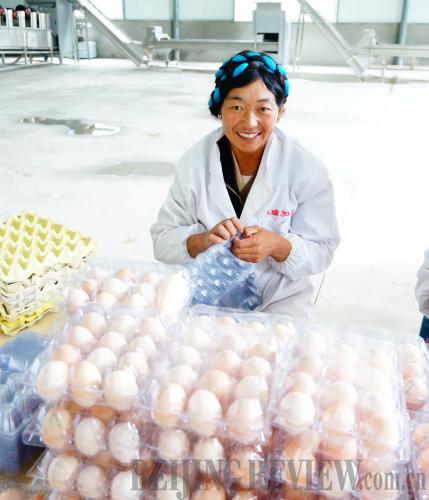|
 |
|
SAFEKEEPING: Nima Dolma, a worker in Tianrui Industry and Trade Co. Ltd., packs eggs on August 16 (ZENG WENHUI) |
According to Du Jiangong, Deputy Director of the Education Department of Tibetan Autonomous Region, since the Central Government launched paired assistance to Tibet in 1994, partnership provinces and municipalities have invested 295 million yuan ($47.2 million) to develop Tibet's education by the year 2000. After the turn of the 21st century, paired assistance to Tibet became more vigorous. Incomplete statistics show that from 2002-13. A total of 1,823 assistance projects have been carried out, under which 6,829 people in Tibet have received training, 3,585 people have been offered education assistance to Tibet, and 530,000 square meters of educational facilities have been constructed.
The Beijing Municipal Government has invested 182 million yuan ($29.63 million) in building Lhasa Beijing Experimental Middle School, which is scheduled to open September 1. With a total construction area of 47,000 square meters, the school has classroom buildings, dormitories, dining halls and a gymnasium. The school's management team and some faculty members are from Beijing.
Zhang Zhihong, the school's deputy headmaster in charge of ethical education, arrived in Tibet in June. Zhang said the school's equipment is first rate in Lhasa, and it is even better than many schools in Beijing. The school planned to enroll about 3,000 students and hire 268 faculty members, including 50 outstanding teachers from Beijing.
"Inadequate education once hampered Tibet's social and economic development. Educational aid promises great hope, and is a valuable assistance," said Lozang Tenpa, Deputy Secretary of the Communist Party of China Lhasa Municipal Committee.
Aiding agriculture
Lines of potato starch noodles were airing outside of spacious factories, rows of tomatoes and marigold flowers interlaced each other in huge vegetable greenhouses, and busy workers were packaging stickered eggs inside workshops. These were scenes at Tianrui Industry and Trade Co. Ltd., an agricultural product planting and processing base in Gonggar County of Shannan Prefecture.
The company's Chairman of the Board, Wang Qinggui, who majored in animal husbandry, was sent by Hunan Province to work in Tibet in 2003. His first assignment was to tackle the low hatchability of Tibetan chickens.
With business acumen and a strong interest in animal husbandry, Wang later quit a local government position and entered business. In 2007, he brought products of Tianrui back to his home province of Hunan. His company participated in an international agricultural exposition held there, and the products of the company won the gold prize, a title they have successfully defended for seven consecutive years. The company had set up sales outlets in 10 provinces in the country, which brought in sales revenue near 100 million yuan ($16 million), Wang said.
The company has contracted 15,000 households in Tibet to raise Tibetan chicken and yaks and plant red potatoes. Nima Dolma, 31, is one of them. She feeds 60 chickens at home, each of which can produce eggs and meat worth 50 yuan ($8). Every year, she can make 3,000 yuan ($462) from raising chickens. In addition, she works in the egg packaging plant of Tianrui, and earns a monthly income of more than 2,000 yuan ($308) there.
Expanding medicare
With assistance from Northeastern Liaoning Province, the Nagqu Prefecture Tibetan Hospital has been expanded to more than 3.5 times its original scale. It has also acquired medical equipment such as CT and color ultrasound machines.
"The hospital has achieved leapfrog development," said Gonpo Wangdu, the hospital's president. "Assistance from Liaoning has greatly improved our diagnostic ability. Now we receive more than 300 patients daily on average."
In addition to funding hospitals, a number of provinces have also sent doctors or set up charitable foundations to provide medical assistance to the Tibetan people.
Saizhoin, a 6-year-old girl living in a village in Maizhokunggar County, has had a foot problem since she was 2 years old. Due to poverty, her parents did not bring her to see a doctor until her condition became very obvious.
At the county hospital, Saizhoin met a doctor from Nanjing. The doctor arranged an operation for the little girl in Children's Hospital in Nanjing, coastal Jiangsu Province. Saizhoin's family received 20,000 yuan ($3,200) of donation money from a charity foundation set up by cadres assisting Tibet. After undergoing the operation in June, the girl returned to Tibet and is recovering quickly.
Email us at: zengwenhui@bjreview.com |
